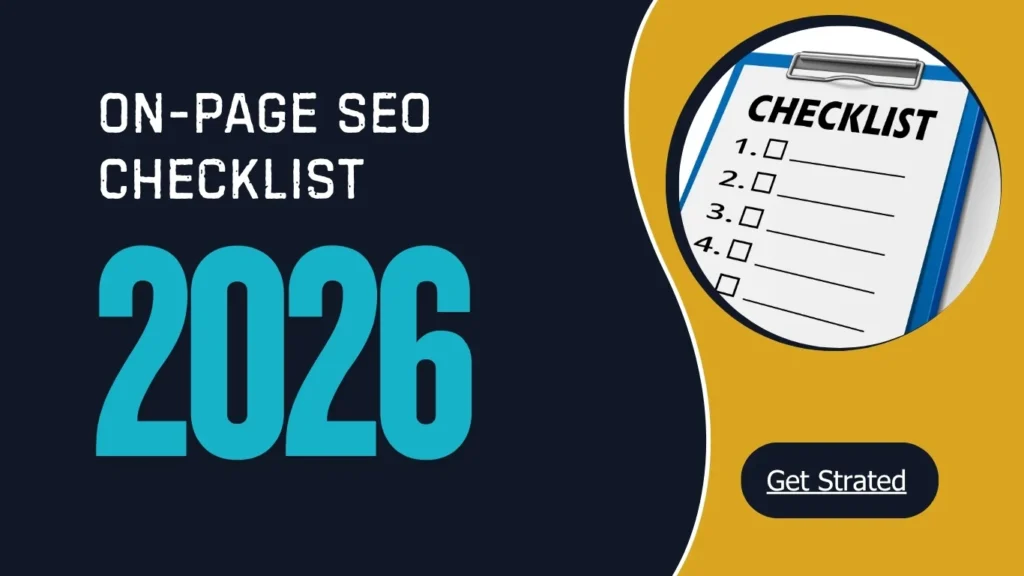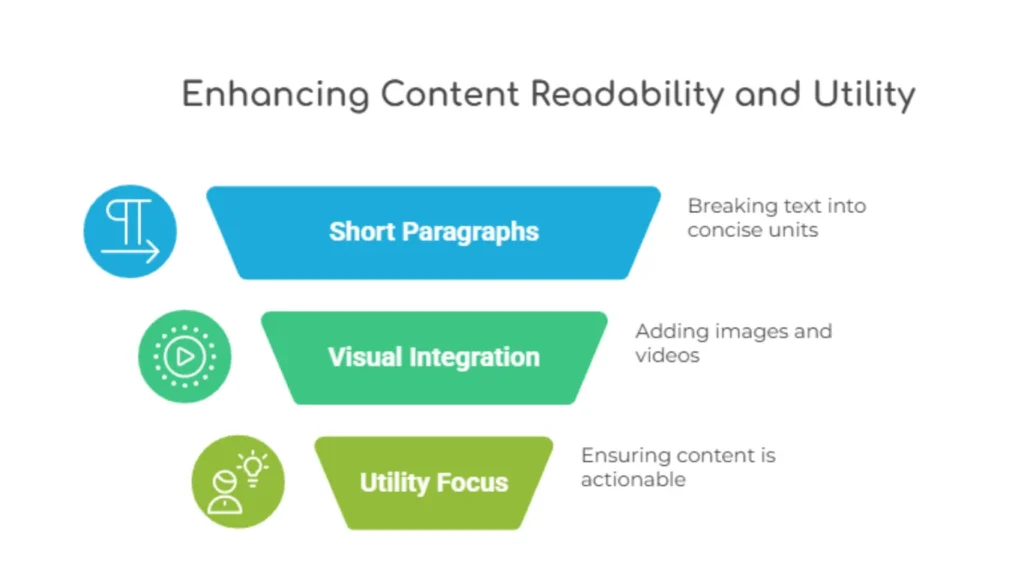Updated On-Page SEO Checklist for 2026

Introduction: Why On-Page Optimization Still Reigns Supreme
Marketers often invest heavily in off-site promotion, but performance data tells a different story: success starts on your own pages. A complete On-Page SEO Checklist ensures your site architecture, keywords, and content all work in harmony to drive sustainable rankings.
This comprehensive On-Page SEO Checklist breaks down the process into easy, actionable phases, ensuring every element of your page—from the code to the content—is perfectly tuned. Whether you’re a digital marketing fresher, a student learning the ropes, or a startup founder trying to capture organic traffic, this guide provides the SEO best practices you need to start ranking higher. We will move beyond vague concepts and give you clear, step-by-step instructions for effective on-page optimization that translates directly into better visibility and increased traffic. Let’s dive in and make sure your page is giving Google exactly what it wants.
Foundational Keyword & Content Optimization
Before you even think about putting pen to paper (or fingers to keyboard), you have to know what your readers are truly looking for. This first phase of the On-Page SEO Checklist is about laying that solid foundation.
A. Primary Keyword Targeting and Intent
If your page is an informational article, but the user’s intent is transactional, you’ve already failed. Your first step in on-page optimization is confirming that your content type matches the query intent. This is a fundamental item in any on-page SEO checklist that separates successful pages from those that languish in search obscurity. Once confirmed, place your primary keyword naturally within the first 100 words of your body copy. This simple step gives both users and search engines instant confirmation that they’ve landed on the right page.
B. Creating High-Quality Content
Google doesn’t just want more content; it demands high-quality content that’s comprehensive, useful, and superior to competitors. Your on-page SEO checklist should focus on strategic keyword placement, satisfying search intent, and creating content that answers every potential follow-up question.
For readability, which is a major factor in modern SEO best practices, structure your work like a human would consume it:

- Keep Paragraphs Short: No one enjoys massive blocks of text online. Aim for 2-4 sentences max per paragraph.
- Use Visuals: Break up large sections with relevant images, charts, or videos.
- Prioritize Utility: Is the information actionable? Does it solve the reader’s problem? If yes, you’re creating high-quality content.
C. Heading Structure: The Content Blueprint
Headings are your page’s internal navigation system. Think of them as a well-organized table of contents.
- H1 Tag: Use one H1 per page matching your primary keyword. This main title anchors your on-page SEO Checklist optimization.
- H2 and H3 Tags: Break your topic into logical sections. Use H2s for main themes and H3s for supporting points. This hierarchy helps search engines understand relevance and improves readability.
HTML & Metadata Checklist (The Click Magnet)
A. Mastering the Title Tag
- Make it Unique and Engaging: Every page needs its own title. Avoid having duplicates across your site.
- Keyword First: Place your primary keyword as close to the beginning as possible. This is prime real estate for effective on-page SEO checklist optimization.
- The Length Rule: Don’t obsess over an exact character count. Instead, aim for a title that isn’t getting cut off (or “truncated”) in the Search Engine Results Page (SERP). Generally, staying under 60 characters is a safe bet.
- Add Brand Recognition: If space allows, include your brand name at the end, separated by a pipe | or a hyphen -. This bolsters your overall SEO strategy.
B. Crafting a Clickable Meta Description
- Solve a Problem: Use benefit-driven language to show readers what they’ll gain by clicking.
- Include a Call-to-Action (CTA): Phrases like “Read the full guide,” “See the latest tips,” or “Start your on-page SEO checklist today” dramatically boost clicks.
- Integrate a Secondary Keyword: Keywords in your meta description get bolded in SERPs when they match user queries—a powerful visual hook that draws the eye.
C. The Clean URL Slug
Finally, the URL should be simple, short, and instantly descriptive. When creating the slug (the part after your domain name), think of it as a clear file path.
Use Keywords: Include your primary keyword, but drop unnecessary “stop words” like “a,” “the,” or “and.” Shorter is better.
Use Hyphens: Always use hyphens (-) to separate words. Using underscores (_) is considered poor form according to modern SEO best practices.
This phase ensures every technical element on your on-page SEO checklist works in harmony with your great content, pushing you toward those top rankings.
Image & Internal Linking Optimization (Structure and Speed)
So far, we’ve nailed the text and the metadata. Now, we’re moving onto the crucial non-text elements and how we weave our site together. This stage of the On-Page SEO Checklist addresses site structure, user flow, and Page Speed—all high-impact ranking factors.
A. Image Optimization: More Than Just Pretty Pictures
- Compression and Format: Always compress your images before uploading. Use modern formats like WebP where possible, and ensure the file size is as small as possible (ideally under 100kb).
- File Naming: Ditch generic names like IMG_001.jpg. Instead, use a descriptive name separated by hyphens (e.g., on-page-seo-checklist-diagram.jpg).
- Alt Text: This is a crucial element for accessibility, as screen readers use it to describe the image. From an On-page SEO Checklist perspective, the Alt Text is the best place to naturally work in your secondary keywords or related LSI (Latent Semantic Indexing) keywords that you might not have used in the main body. Keep it descriptive, but treat it like a sentence that genuinely describes the image.
B. Internal Linking Strategy: Building Topical Authority
- Anchor Text: When you link internally, use relevant anchor text that contains the keyword of the destination page, not the source page. For example, if you’re linking to your SEO Service Page, the anchor text should be “SEO Services in India,” not just “click here.”
- Contextual Links: The best internal links are placed naturally within the body of your content, not in footers or sidebars. Aim for 3-5 relevant internal links per article, and always link back to the homepage using your brand name. This strategy is vital for a robust overall SEO strategy and any comprehensive on-page SEO checklist.
The Complete On-Page SEO Checklist (Consolidated)
| Item | Optimization Goal & Best Practice |
| Search Intent Match | Confirm your content type (e.g., guide, product page) matches the user’s underlying search intent (informational, transactional). |
| Primary Keyword Intro | Place the primary keyword naturally within the first 100 words of the body content. |
| H1 Tag | Use only one H1 tag per page; it must accurately describe the page’s main topic and ideally include the primary keyword. |
| Title Tag | Keep it under 60 characters, compelling, and place the primary keyword as close to the beginning as possible. |
| Meta Description | Write a persuasive, benefit-driven pitch (around 160 characters) with a clear Call-to-Action (CTA) to maximize CTR. |
| Canonical Tag | Ensure the canonical tag is pointing correctly to the preferred version of the page to prevent duplicate content issues. |
| H2/H3 Structure | Use H2s and H3s logically to break down the topic, making the content easy to scan for users and easier for search engines to understand the hierarchy. |
| Internal Links | Include 3–5 contextual internal links to relevant, high-value pages on your site, using relevant anchor text. |
| Image Alt Text | Provide descriptive Alt Text for all images, incorporating relevant secondary keywords naturally for accessibility and context. |
| Image Speed | Compress all images (ideally <100kb) and use modern formats (like WebP) to ensure fast Page Speed. |
| Secondary Keywords | Ensure related LSI keywords and variations of your primary topic are integrated naturally throughout the body text to build topical depth. |
| URL Slug | Keep the URL slug short, readable, keyword-focused, and use hyphens (-) for word separation. |
| External Links | Include 1–2 high-authority, relevant external links pointing to non-competing sources for credibility. |
| Readability | Ensure short paragraphs (2-4 sentences max), use bullet points, and maintain sufficient whitespace for an excellent user experience. |
Conclusion: Final Checks and Long-Term Success
You’ve made it through the core of the On-Page SEO Checklist! If you’ve followed these steps—from validating search intent in Phase 1 to perfecting your Alt Text and internal links in Phase 3—you now have a strong, well-optimized page ready to compete.
Remember, SEO best practices aren’t a one-time thing; they’re an ongoing effort. Even after publication, your on-page optimization duties continue. Monitor your page’s performance using tools like Google Search Console and Analytics. Look for opportunities to update outdated information, improve sections with low dwell time, and expand the content to capture new long-tail secondary keywords. Regularly revisit your on-page SEO checklist to ensure nothing’s overlooked. By treating your published work as a living document and continually aiming for high-quality content, you ensure your SEO strategy delivers sustainable organic traffic and stays ahead of the competition. Great job—now go crush the rankings!
